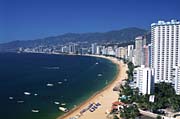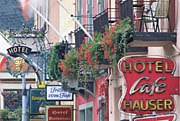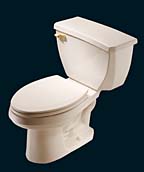
Fixtures are fixtures...and they're not. All plumbing fixtures, whether destined for residential or commercial use, must meet the design, dimensional and functional requirements of ASME/ANSI A112.19.2M. Since the implementation of the Energy Policy Act of 1992, all fixtures must also meet water conservation requirements.
Hospitality fixtures can be defined as the traditional plumbing fixtures used in hotels, motels, resorts and restaurants. A reasonable case can be made to include categories such as hospitals or longer-term health care facilities in the definition of hospitality, but for the purpose of this overview, we will use the relatively narrow definition of hotels, motels, resorts and restaurants. Fixtures is also a term with potentially broad interpretations; however, we will limit our discussion to traditional plumbing fixtures--lavatories, toilets and urinals. Some upscale facilities also include bidets in many rooms, but they are the exception and will not be included here.
The same general rules apply when selecting plumbing fixtures for hospitality versus residential projects, but there are additional criteria based on fulfilling the needs of the owners and operators of hospitality facilities. As part of the service industry, the owners and operators of hospitality facilities operate with two basic rules:
- 1) Make the customers' stay as enjoyable and pleasant as possible, thereby increasing the likelihood they will return or at least provide positive recommendations to others, and
2) Run the operation as cost effectively as possible. Put very simply, the owners and operators demand product performance. Ideally, products should work as they are designed with no interruptions for the guests and minimal maintenance (or cost) to the management.
In general, simple, smooth design lines are preferred for ease of cleaning and general appeal to the average hospitality guest. The materials must be durable due to the high use (and sometimes abuse) these facilities receive.
The vast majority of fixtures used in these facilities are white. Owners and property managers insist that all fixtures meet a narrowly defined color specification, often resulting in a preference for only one manufacturer's products used throughout the facility.
Finally, there is a growing requirement that the facilities be ADA compliant. The aging baby boomer demographic bulge will generate an increasing need for products more suited to their lifestyle. Higher toilets made to meet ADA requirements are becoming more popular with the general public because they are simply considered more comfortable by many people.

Upscale/Themes
Plumbing fixtures in hospitality facilities generally use generic styling. However, there are certainly some newer resorts that employ a theme throughout. From the overall architecture of the buildings to the uniforms of the service staff to the furnishings in the rooms, a pervading theme is carried through. In these upper-end projects, we are seeing more upscale fixtures such as one-piece toilets and pedestal lavatories. However, these will continue to be the exception rather than the rule.
Lavatories
Lavatories are available in numerous materials, including vitreous china, porcelain-enameled steel and solid surfaces such as Corian. Typically, vitreous china is preferred in hospitality environments because it doesn't dent or chip as easily as steel, and it is generally more cost effective than the solid stone or composite materials.Lavatories may either be self-rimming (countertop mounted) or undercounter mounted. Some newer, higher end projects may specify pedestal lavatories, but again these are the exception. Undercounter-mounted lavatories are popular in hospitality applications because a smooth countertop allows for easy cleaning. Undercounter-mounted lavatories can also be attached to the countertop offsite to save time during onsite installation.
All lavatories must meet the dimensional requirements of ASME/ANSI A112.19.2M to allow a variety of common faucets to be installed. Four-inch faucet spacing (centerset) and a generously sized faucet deck are often preferred for ease of cleaning.
Toilets
Bathrooms in hotels and resorts typically get regular, if not heavy use by people who do not own them. Consequently, these units must be designed to take some abuse and continue to perform. The toilets in the public areas of the buildings are often commercial spud-type bowls with flushometer valves due to the higher frequency of use. Since these are pressure-assisted units, back outlet floor- and/or wall-mounted bowls are more common and rarely have a performance problem. Wall-mounted models do provide for easier floor cleaning and maintenance.In the guestrooms, toilets may be either gravity tank- or flushometer tank-type toilets. Many hospitality facilities now specify that gravity toilet tanks include a pilot-style fill valve rather than a standard ballcock. Pilot-style fill valves perform more consistently over the various supply line pressures that can be encountered in multi-story buildings. In addition, hospitality applications may require metal trip levers and locking tank covers to reduce breakage due to abuse and potential tampering.
Frustration, aggravation and embarrassment are some of the worst experiences a hotel or resort guest can experience, and the toilet has the potential to create all of them quickly if things go wrong. Well-performing toilets are absolutely critical in hospitality applications. It is difficult to quantify the cost of a lost customer, but it certainly doesn't take many to justify installing a well-performing toilet. Of the numerous industry tests used to measure toilet performance, how well the bowl clears solid waste is the most important for hospitality applications. If the bowl clogs, there is, at the least, an unhappy guest, and at the most, a messy cleanup and the potential for water damage to that room and the room below. Drainline carry is often less of a problem in hospitality applications than some other commercial applications due to the relatively frequent vertical stacks, as well as additional water from showers and other rooms using the same line.
Gravity tank-type toilets have dramatically improved since the Energy Policy Act of 1992 mandated 1.6 gpf toilets for use in both residential and commercial applications. Most gravity tank toilets work well in residential applications. However, some toilet manufacturers still recommend pressure-assist toilets for commercial applications, and a growing number of hospitality facilities specify pressure-assist toilets as well. The reason is simple--the larger trapway typical in these designs, along with a pressure-assisted jet, result in efficient waste removal and few plugs. And, with a minimum of moving components, they require only minimal maintenance.
The manufacturers of the fixtures as well as the pressure vessels are working to reduce the noise level often associated with these units, which can be disconcerting to some. Also the makers of pressure vessels are doing extensive testing with four-liter toilets (1.0 gallon per flush), which could improve the savings in water even further.